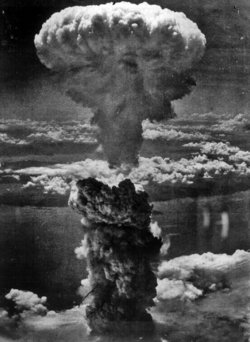This has got to be one of the silliest things I have ever heard in my lifetime.
Bomb people 'til hell won't have it, occupy their country for over 4 years while committing one heinous crime after another against their citizenry, do little or nothing to repair the damage you've done and then tell them you are "there to help them."
"We will help you"
What kind of idiot would believe such a thing.
Iraqis aren't stupid.
But we are, apparently, because there will be a whole bunch of wing-nuts who will be pushing and believing this silly mantra.
What is it going to take to get it though the thick skulls of the D.C. Dumb-asses that the Iraqis don't want us there, period. They don't want our help. They have had quite enough of our "help" as it is.
How is it possible that anyone can be so stupid as to believe a word of this blather?
The Pentagon Gets a Lesson From Madison Avenue
U.S. Needs to Devise a Different 'Brand' to Win Over the Iraqi People, Study Advises
By Karen DeYoung
Washington Post Staff Writer
Saturday, July 21, 2007; A01
In the advertising world, brand identity is everything. Volvo means safety. Colgate means clean. IPod means cool. But since the U.S. military invaded Iraq in 2003, its "show of force" brand has proved to have limited appeal to Iraqi consumers, according to a recent study commissioned by the U.S. military.
The key to boosting the image and effectiveness of U.S. military operations around the world involves "shaping" both the product and the marketplace, and then establishing a brand identity that places what you are selling in a positive light, said clinical psychologist Todd C. Helmus, the author of "Enlisting Madison Avenue: The Marketing Approach to Earning Popular Support in Theaters of Operation." The 211-page study, for which the U.S. Joint Forces Command paid the Rand Corp. $400,000, was released this week.
Helmus and his co-authors concluded that the "force" brand, which the United States peddled for the first few years of the occupation, was doomed from the start and lost ground to enemies' competing brands. While not abandoning the more aggressive elements of warfare, the report suggested, a more attractive brand for the Iraqi people might have been "We will help you." That is what President Bush's new Iraq strategy is striving for as it focuses on establishing a protective U.S. troop presence in Baghdad neighborhoods, training Iraq's security forces, and encouraging the central and local governments to take the lead in making things better.
Many of the study's conclusions may seem as obvious as they are hard to implement amid combat operations and terrorist attacks, and Helmus acknowledged that it could be too late for extensive rebranding of the U.S. effort in Iraq. But Duane Schattle, whose urban operations office at the Joint Forces Command ordered the study, said that "cities are the battlegrounds of the future" and what has happened in Baghdad provides lessons for the future. "This isn't just about going in and blowing things up," Schattle said. "This is about working in a very complex environment."
In an urban insurgency, for example, civilians can help identify enemy infiltrators and otherwise assist U.S. forces. They are less likely to help, the study says, when they become "collateral damage" in U.S. attacks, have their doors broken down or are shot at checkpoints because they do not speak English. Cultural connections -- seeking out the local head man when entering a neighborhood, looking someone in the eye when offering a friendly wave -- are key.
The most successful companies, the Rand study notes, are those that study their clientele and shape their workplace and product in ways that incorporate their brand into every interaction with consumers.
Wal-Mart's desired identity as a friendly shop where working-class customers can feel comfortable and find good value, for example, would be undercut if telephone operators and sales personnel had rude attitudes, or if the stores offered too much high-end merchandise. For the U.S. military and U.S. officials, understanding the target customer culture is equally critical.
Helmus recommends expanding military training to include shaping and branding concepts such as cultural awareness, and the study underscores the perils of failing to understand your consumer.
"Certain things do not translate well," the study warned. "Danger lies behind assumptions of similarity." A gesture Bush made during his 2005 inaugural parade -- the University of Texas "hook 'em horns" salute with raised index and pinkie fingers -- stands for the "sign of the devil" in some cultures and an indication of marital infidelity in others. A leaflet dropped to intimidate Iraqi insurgents, the study noted, "also reached noncombatants" and "gave everyone who picked it up the 'evil eye.' "
"Words cause similar cultural confusion," it said. The Arabic word "jihad," for example, has religious connotations for Muslims; its repeated use to connote terrorism is insulting and also perversely lends legitimacy to violent acts.
Schattle acknowledged that much of what works for consumer advertising in the United States might not translate well in Baghdad. But urban ops, he said, is all about experimenting and adapting to new realities.
"We want to look at new concepts, new business practices, to see if there are things that we can learn," he said. Since his office was established after the U.S. military issued a new doctrine for urban warfare in 2002, "we've been collecting lessons learned from all over the world," he said. "Not just Iraq and Afghanistan, but places like the Philippines and South America. Wherever there have been fights, we went out and looked at them."
The challenge for the advertising study, he said, was to find "something we can learn from Madison Avenue or from the marketers, the best in the world, that might help us when we're trying to deliver a message about what democracy is." In Iraq, Schattle said, the "urban population is the center of gravity" and the problem is "how we influence them to be on our side, or at least not be an enemy" when "what they see is armor." The goal of such studies, Schattle said, is to distill what works and incorporate it into future training.
Adversaries are doing their own shaping on Iraq's urban battlefields. While intimidation, coercion and assassination might not make them beloved, such techniques effectively limit public outreach to U.S. forces, the Rand study notes. Enemy forces have also learned that "doing good works is a classic approach to winning friends and influencing people" and frequently provide basic services that the U.S. military is unable to match.
At the same time, Helmus said, U.S. military and civilian authorities must stop thinking of themselves as a "good-idea factory" whose every thought has greater merit than those of their customers. "Procter & Gamble doesn't even do that," he said.
(In accordance with Title 17 U.S.C. Section 107, this material is distributed without profit to those who have expressed a prior interest in receiving the included information for research and educational purposes. The Lantern has no affiliation whatsoever with the originator of this article nor is The Lantern endorsed or sponsored by the originator.)
....And The Truth Shall Set Us Free






